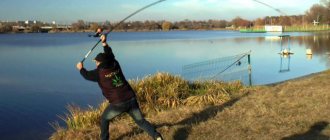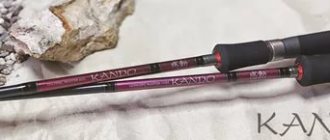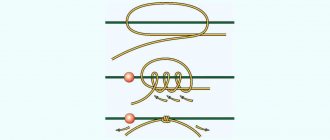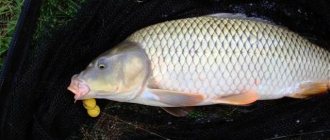casting over long distances, over 100 m, is simply necessary on many reservoirs. And this applies not only to sports tournaments, when the fish, experiencing great pressure from competitors, move away from the shore. Imagine a hot summer day and a body of water where you are allowed to swim. You can only catch a decent carp near the shore at night, if you’re lucky and the “cheerful children’s laughter” subsides around you. The same applies to bodies of water near noisy roads. Add situations when an interesting edge or other carp habitat is located 120 meters from the casting point. In addition, trophy carp themselves are more careful than their young relatives. So very often two tasks - catching a good carp and casting them far - have to be solved simultaneously.
RODS
rods for carp fishing on sale.
, differing from each other not only in price, but also in characteristics - the material from which the form is made, length, action, optimal load and others
It is impossible to create a rod that works effectively in all situations that we encounter in carp fishing today. For successful fishing, several different types of rods are simply necessary: for a marker - one, for a feeder rocket - another, for fishing at medium distances up to 80-100 m - a third, for long distances over 100 m - a fourth.
For several years now I have been using a 12ft (3.6m) rod with 3lb test and 7 SiC guides for carp fishing. The rod works just fine both when casting a 3 ounce (85 gram) sinker and when landing fish. But I couldn’t cast this rod more than 90 m. You say, you should have replaced the sinker with a heavier one, 4 ounces (113 grams) or more. I tried it, but when casting such a sinker the result was even worse: I “lost” several meters.
The ideal performance of my rod with 3lb test and 3.6m length is rated for a 3oz weight. I won’t go deep into physics, but with such a load the blank clearly, without overload, provides the longest cast. Anything more than this is overload, which means incorrect operation of the form and loss of casting range.
So to get more distance I need a longer rod with a higher test weight.
Rings also play a big role. There should be no more than seven of them on the rod, and the diameter of the first ring should be at least 40 mm. Another component is the length of the rod from the reel seat to the butt. It varies, and depending on your height, it will have a big impact on the torque during the cast.
So I settled on a 13ft (3.9m) rod with 3.5lb test, fast action, titanium guides with SiC inserts that works great with 4 to 5 oz (113-142 gram) weights. Such a rod will accurately cast to the maximum distance and will work great when landing fish.
Another factor that plays an important role in ultra-long casting is your physical fitness and casting technique. Different people casting with the same identically equipped rod will get different results. And here lies the main difficulty in choosing a fishing rod. After all, trying to make several swings with a rod, which can often be seen in the store, is quite pointless. Yes, you can match a rod and reel. You can try, as they say, “whether the rod fits your hand.” But in order to determine whether a particular rod is optimal for your casting style, you need to at least fully rig it and, when you go outside, make a few test casts without the risk of hitting someone in the head with a heavy sinker. The task, you see, is impossible in most retail outlets. Therefore, we can only advise, if possible, to test several rods of your friends, and then choose the best option.
Considering the above, I do not list specific rod models. The choice depends on your physical condition, and often on the thickness of your wallet.
What other factors are important for maximum casting? This is a reel, fishing line, shock leader and equipment.
Casting technique - how to do it correctly?
I immediately warn you that the starting position (for long-distance/universal casting) will be very unusual for many people! That is why, in order to study it (and feel it) normally, it is best to first use only a “bare” rod (i.e. without a sinker or equipment). You can see how the starting position looks from the outside in the photographs.
The first important point is the specific placement of the legs. Your feet should be located at a comfortable distance from each other, and “look” exactly 45 degrees (relative to the casting direction). It is worth noting that this is one of the most convenient throwing positions, often used in a wide variety of throwing sports.
The second, no less important nuance is the unnatural (for many of us) location of the waist. That is, it should be turned so that your chest is perpendicular (relative to the direction of casting), i.e. at an angle of 90 degrees. As for the arms, the left one should be as straight as possible and located slightly above the head, and the right one should be slightly bent (both for your convenience and for tilting the rod so that its tip almost touches the ground).
Take a close look at photo No. 1, where I showed what the starting position for long/universal casting should actually look like. Be sure to pay your attention to your left hand - it should be positioned high, which is necessary to obtain greater leverage, and, accordingly, a larger arc. Your face should be turned directly to the target, but your eyes should look a little higher (so that later you can complete your cast in time).
LONG CASTING REELS
Reels with a small spool will not be the best choice for ultra-long casts. Today on the fishing market you can see reels with large spools, the so-called Big Pit Reels, which are used for sea fishing and which have become a necessity in long-distance carp fishing. These reels have a tapered spool with a low side, with a diameter of 70 to 85 mm, which allows the line to flow freely with minimal friction. Daiwa and Shimano are leaders in their production.
For carp fishing, reels with a baitrunner are available, although its presence (as not only I, but also many of my sportsman friends believe) is not necessary. All of them have an unsurpassed soft grip system, which allows you to very successfully catch caught fish.
A large spool makes it possible to lay from 350 to 630 meters of fishing line with a diameter of 0.3 mm, which is also important for “walking” a trophy specimen over a considerable distance, and a large handle will make it easier to reel in the equipment. Let me give you a few examples: with a batrunner: Daiwa Infinity IF-X 5000 or 5500; Shimano Big Baitrunner LC, Snimano Power Aero XT-10000; without fightrunner: Daiwa Tournament Entoh T-5500, Emblem Exeler EME-5500, Shimano Aero Techium XT-10000, Ultegra XT-10000/12000/14000, Titanos XT-10000.
All these reels will increase your casting distance; they belong to the super class, although they are not cheap, but they are worth it.
Fishing time
The best time to catch carp with a float rod is in warm weather, on sunny days in late spring.
, and of course
in the summer
.
If there is a sudden change in weather, it is better to postpone fishing; there will be no bite. Warm weather has a good effect on fish, but if it gets too hot
, then the carp will lie to the bottom and begin to eat
much worse
. Moderate air temperature and stable cloudiness or sunshine are a call to go fishing. Strong wind gusts also negatively affect the catch.
Now we will give some tips on choosing the time and weather for going fishing, guided by which you will never return home empty-handed.
- The minimum water temperature should be +15 °C. The fish begins to show activity even at a temperature of +10 ° C, but as it rises, the activity increases sharply.
- It is best to catch carp at dawn and at lunchtime.
- When the moon is young, fish also bite at night. But you can count on a constant bite in the dark only after the water has warmed up by more than +20 °C. At this water temperature, it is unlikely that you will be able to fish during the day.
- You can count on a stable bite only 2-3 weeks after the end of spawning.
- Light breezes and cloudy skies make for excellent carp fishing weather.
- Carp are caught very well in pools (you just need to attach a fairly powerful leash to the rig).
- About a day before the big rain, the carp bite very well.
LESKA
For long casts I use Fox Soft Steel line with a diameter of 0.3-0.34 mm. Excellent fishing line with virtually no memory, sold in large reels up to 1350 meters. Of course, to increase the range, you can use a thinner line. But I would recommend doing this only in very few situations: - there are no snags in the fishing area; — there are no shells, sharp stones, etc. at the bottom; — you have experience in catching large fish with thin tackle.
Otherwise, the likelihood of disappointment is too great.
Technique and tactics
Catching carp with a float rod is considered one of the most effective and simplest; among other gear, a fishing rod equipped with a float is simple and versatile. But not everyone succeeds in catching large carp with a float.
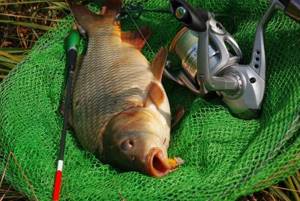
The choice of fishing location is usually limited by the casting range of the float, which is quite small. Large fish stand at great depths, far from the shore; medium-sized fish feed close to it, but more often small fish. And even if you are lucky enough to catch a fish weighing about 10 kilograms, it will be quite difficult to pull it ashore.
Fishermen consider the normal weight of a caught fish to be 1-4 kilograms; such a carp will not be difficult to pull ashore, but the positive emotions will be very great. And many of you may have noticed that the meat of fish of this size is more tender and tastier than that of large carp.
Now let’s digress a little and watch a video about fishing for carp with a float rod, and then continue to consider the theoretical part about choosing a place, time, bait and groundbait for fishing for carp.
SHOCK LEADERS
When carp fishing I always use a shock leader
, and at ultra-long distances it is a mandatory element of equipment to reduce the likelihood of line breakage when casting.
Today, stores have a large selection of shock leaders - from regular to cone. Conical most often has a diameter of 0.34 mm at one end and 0.50 mm at the other, the breaking load is about 15 kg. Naturally, the thinner end is tied to the main fishing line.
The best choice, in my opinion, would be Fox's Tapered-Soft Steel 12Lb-35Lb or Kryston's regular Quicksilver 35Lb. Both have top-notch abrasion resistance and very low memory, allowing for easy passage through rod guides. Instead of specialized shock leaders, you can use a fishing line with greater tensile strength, for example, with a diameter of 0.45-0.5 mm with a main fishing line of 0.30-0.35 mm. It is advisable to make short shock leaders, no more than 2-3 turns of the reel, otherwise this will greatly reduce the casting distance.
It is also important to pay special attention to the correct attachment of the shock leader to the main fishing line. On the left I show several options for the knots I use.
It is worth remembering that after tightening the knot and cutting off the excess line, you need to leave the ends about 5 mm long, otherwise the knot will be too rigid and will knock on the rings when casting. It is also worth gluing it for reliability with special glue Knot-Lock (Rig Glue) from Fox or Bondage Rig Glue from Kryston.
Naturally, after tying the knot should be carefully checked and, if you have any doubts, re-tied.
Tackle
The most effective, simple and time-tested is the fly rod
. Versatility, ease of operation and ease of manufacture make this type of fishing rod most suitable for this type of fishing. But it is not suitable for fishing from a boat; it can only be fished in bodies of water without a current and from the shore. Well, for fishing in reeds or small ponds there is simply no replacement for it.
Choose the lightest possible rod, up to 6 meters long and equipped with guide rings
. It is worth equipping it with a powerful inertia-free reel and properly setting the friction brake, because sharp jerks of large fish can easily leave you without gear. With proper adjustment of the clutch, fishermen are able to catch ten-kilogram carp on a fishing line with a breaking load of about 5 kg.
If catching carp with a float rod will take place on a river or other body of water with a current or abundant vegetation at the fishing site, then you should give preference to a plug rod
. The structural features of such a fishing rod make it possible to deliver bait to a feeding place over long distances (about 15-2 meters).
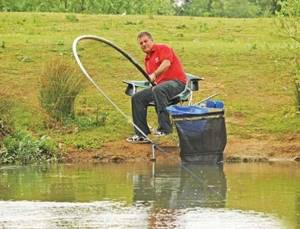
Well, where would we be without a match fishing rod
, which allows you to fish over long distances. A feature due to which the match is quickly gaining momentum among carp fishing enthusiasts is the ability to make long casts without any special obstacles.
The ability to catch carp in areas distant from the shore is provided by the sliding float for long casting, which is equipped with the rod. The small cross-section, built-in weight and streamlined shape allow such a float to be delivered over a distance of about 50 meters.
Fishing rod rig
Equipping a float rod for carp is the same as for fishing for any other peaceful fish. There are no special requirements for choosing the shape of the float, the main thing is that its antenna has a minimum diameter. You should be very careful when loading it - only the tip of the float should be visible from the water
. Thanks to this, the float will have maximum sensitivity. You will be able to notice the fish biting in advance and can prepare for hooking.
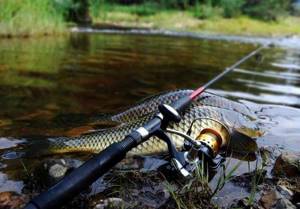
A lot of people believe that carp fishing can be done without using a leash, and they are mistaken. Undoubtedly, the leash is considered the weakest point of the equipment, but if it is tied correctly, the result will be visible immediately. Carp are very cautious and shy fish, so using a leader and fluorocarbon line will give you an advantage over them
As practice shows, hooks of size 6-8 are quite sufficient
according to domestic numbering. It is best to choose special carp hooks, fortunately they are produced in a separate class and their choice is quite simple, so making suitable tackle will not be difficult.
EQUIPMENT
The ideal option would be a helicopter rig using as short a leader as possible. Although, of course, you can use the same equipment as when fishing at short and medium distances. I like to keep systems as simple as possible to avoid any possibility of overlap or twisting.
Anti-twist devices made of a silicone tube or a special Lead Core cord with a lead core inside are required. Try to make the rigs as harmonious as possible.


